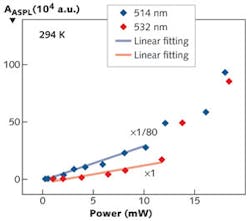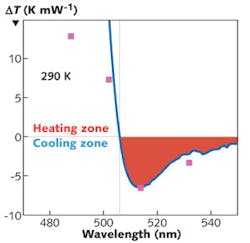CHILLERS AND COOLERS: Breakthrough of optical refrigeration: Laser cools a semiconductor by 40 K
JUN ZHANG, DEHUI LI, and QIHUA XIONG
From daily experience, we know that matter is heated when it absorbs light; in just one example, lasers can be used for industrial machining and cutting. The idea that laser light can cool rather than heat matter is counterintuitive; but in fact, laser light has been used to cool diluted atomic gases and certain rare-earth-element-doped glasses and crystals for the past 30 years.
Now, our group at Nanyang Technological University has demonstrated that a red-detuned laser can cool a semiconductor from room temperature down to -20°C.1 This achievement is a substantial step toward all-solid-state semiconductor optical cryocoolers that are vibrationless, cryogen-free, compact, highly efficient, and possibly even directly integratable into electronic and optoelectronic devices.
History of optical refrigeration
Laser cooling of solids is also known as optical refrigeration, proposed in 1929 by the German physicist Peter Pringsheim nearly 30 years before the laser was invented. In this process, the material to be cooled is irradiated by red-detuned (lower-energy) monochromatic light; as a result, spontaneous emission of higher-energy luminescence (a process called luminescence upconversion or anti-Stokes luminescence) can be excited.
Lattice vibrations (or, in the language of quantum mechanics, phonons) provide the necessary energy and momentum to satisfy the conservation laws. As such, the lattice vibrations are annihilated-that is, the heat is converted into light.
There was some argument whether an optical refrigerator violates the second law of thermodynamics, until Russian scientist Lev Landau assigned entropy to optical irradiation in 1946. Based on the second law of thermodynamics, work must be done to reduce the entropy of the system in order to cool it. In optical refrigeration, the pump laser is a monochromatic source of light exhibiting low entropy, while the spontaneous emission has a broadband nature, thus having high entropy. It is the pump laser that does the work to drive the cooling; therefore, the second law of thermodynamics is obeyed.
This principle proposed by Pringsheim was later used to cool dilute atomic gases based upon the well-known Doppler effect. Dilute atomic gases can be cooled to very low temperatures—in fact, down to the nano-Kelvin regime. At such low temperatures, the quantum ground state is accessible; this has led to the discovery of many exciting phenomena, including Bose-Einstein condensation, quantum manipulation, and entanglement of single atoms.
Laser cooling of solids has a similar physical origin, but with a substantial difference: the atoms in solids have no translational kinetic energy and momentum, as the atoms are locked in a crystalline lattice. However, solids have abundant lattice vibrations that provide the extra energy for upconversion. Thirty years after Pringsheim proposed the concept of laser cooling, French physicist Alfred Kastler suggested that rare-earth-doped solid material may have the potential for laser cooling of solids.
Since then, there have been many failed attempts at finding workable laser cooling materials-at least until 1995, when Richard Epstein and his group at Los Alamos National Laboratory (Los Alamos, NM) realized cooling on the order of 0.3 K in a high quality Yb3+-doped glass. Just recently, the Mansoor Sheik-Bahae group at the University of New Mexico (Albuquerque, NM) has cooled Yb3+-doped LiYF4 crystals from room temperature through a net temperature drop of 190 K (allowing, for example, indirect cooling of semiconductor "payloads"). This is the cooling limit for rare-earth-doped materials; below this temperature, similar materials cannot efficiently absorb the pump photon because the atomic resonances follow the Boltzmann distribution and the upper levels of ground state manifold become depopulated.
However, direct-bandgap semiconductors have a higher cooling efficiency and a lower theoretical cooling limit of about 10 K, because excitonic levels dominate the absorption band and the carriers follow the Fermi-Dirac distribution. If laser cooling of semiconductors could reach 10 K, laser cooling could potentially be used to replace liquid-helium cooling for many applications. In addition, semiconductor optical cryocoolers could possibly be integrated with electronic and optoelectronic devices.
Although researchers have devoted much theoretical and experimental effort toward laser cooling of semiconductors using group III-V gallium arsenide (GaAs) quantum wells, no net laser cooling has ever been achieved. This is because group III-V semiconductor materials have a weak electron-phonon coupling strength, a high reabsorption effect of luminescence due to the large refractive index, and a large surface-recombination velocity.
Laser cooling of a II-VI semiconductor
Our group has discovered that II-VI group semiconductor cadmium sulfide (CdS) nanoribbons exhibit strong exciton longitudinal optical (LO) phonon coupling, leading to a strong luminescence upconversion facilitated by annihilation of multiple LO phonons (see Fig. 1). We have further demonstrated the first successful laser cooling in CdS nanoribbons to about 40 K from 290 K when pumped by a 514 nm green laser (see Fig. 2). We showed that about 15 K of cooling can be realized even when starting at a low temperature of 100 K when pumped by a 532 nm laser; at the same time, the temperature of the sample is measured by monitoring the Stokes photoluminescence peak shift with an additional laser emitting at 473 nm at a very low power, with its light focused at the same spot as the pump-laser light.The success of this laser-cooling experiment can be attributed to two factors. The first is a strong electron-phonon coupling, which makes it possible to resonantly annihilate more than one LO phonon during each upconversion cycle and thus more effectively remove the heat from the CdS nanoribbons. Secondly, the luminescence escape efficiency of the upconverted photons approaches unity because the nanoribbon thickness used in the experiment is less than half the wavelength of the fluorescence photons; this prevents the luminescence reabsorption and recycling that usually generate heat.
This work opens the way to a search for other laser-cooling materials with strong electron-phonon coupling strengths, and also implies that other II-VI semiconductors may potentially be laser-cooled experimentally.
Laser cooling of semiconductors has many potential uses. One possibility is the cooling of high-sensitivity sensors and detectors in space. Currently, most space cryocoolers are mechanical or cryogen-based; in contrast, optical refrigerators have no moving parts or cryogens.
Another possible application is on-chip coolers for electronic or optoelectronic devices, including superconductor electronics. In addition, our results suggest that a radiation-balanced laser (a so-called athermal laser) is possible if a suitable gain-medium mechanism can be established in the material that is being laser-cooled. Of course, the current challenge is in scaling up laser-cooled devices to a practical size—for instance, to establish laser cooling in a bulk crystal.
REFERENCE
1. J. Zhang et al., Nature, 493, 504 (January 24, 2013); doi:10.1038/nature11721.
Jun Zhang, Dehui Li, and Qihua Xiong are at the School of Physical and Mathematical Sciences, Nanyang Technological University, 21 Nanyang Link, Singapore 637371; e-mail: [email protected].

